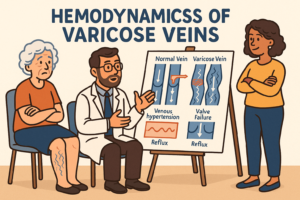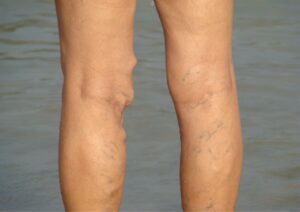Are you experiencing a soft, blue bump on your skin that looks like a blood-filled blister? It could be a venous lake. Despite its harmless nature, a venous lake can cause anxiety, pain and discomfort due to its appearance. But fear not, we have you covered. In this comprehensive guide, we will dive deep into the world of venous lakes, uncovering their common causes, symptoms, and available treatment options.
From understanding the underlying factors that contribute to the development of venous lakes to the potential causes and exploring various medical and home remedies, we will provide you with the knowledge you need to tackle this condition head-on. Whether you’re seeking professional medical treatment or prefer a more natural approach, we will explore all the potential causes and solutions for you.
Our aim is to empower you with the necessary information to make informed decisions about your health. So, if you’re ready to bid farewell to those pesky venous lakes and regain your confidence, let’s explore the world of venous lakes together. Welcome to our comprehensive guide on what a venous lake is and how to effectively treat it.
Understanding the causes of venous lakes
Venous lakes are benign, vascular lesions that occur when small blood vessels, called venules, become enlarged and congested with blood. It occurs mainly on the lower lip but can also occurs on the upper lip. These lesions commonly appear on the lips, face, ears, and other sun-exposed areas of the body. The exact cause of venous lakes is still unknown, but several factors contribute to their development.
Excessive sun exposure is one of the main culprits behind the formation of venous lakes on the lower lip. Ultraviolet (UV) rays from the sun can damage the collagen and elastin fibers in the lips and skin, weakening the blood vessels and causing them to dilate. Additionally, genetic predisposition, aging, and hormonal changes can also play a role in the development of venous lakes.
While venous lakes can affect individuals of any age or gender, they are more commonly observed in older adults and those with fair skin. Understanding the disease and underlying causes can help you take proactive steps to treat and prevent the formation of venous lakes.
Signs and symptoms of venous lakes
Venous lakes typically present as soft, blue or purple bumps on the skin’s surface. They are often described as blood-filled blisters or lesions that can be easily compressed. These bumps are usually painless and do not cause any physical discomfort. However, the cosmetic appearance and pain of venous lakes can lead to self-consciousness and a desire for treatment.
One distinguishing feature of venous lakes is that they may darken or become more prominent when exposed to cold temperatures or pressure. This characteristic is known as the “blanching effect” and can help differentiate venous lakes from other skin conditions.
It is important to note that venous lakes are generally harmless and do not pose any significant health or infection risks. However, if you notice any changes in size, shape, or color, or if the lesion becomes painful or starts to bleed, it is advised to seek immediate medical attention for proper diagnosis and treatment.
Diagnosis and identification of venous lakes
Diagnosing a venous lake is usually straightforward and can often be done through a visual examination by a healthcare professional. However, in some cases, further diagnostic tests may be necessary to rule out other conditions or confirm the diagnosis.
Dermoscopy, a non-invasive technique that uses a specialized handheld device to magnify the skin’s surface, can be used to examine the characteristic features of venous lakes. This technique helps identify the dilated blood vessels and assess their depth and distribution within the lesion.
In rare cases where the diagnosis of melanoma is uncertain, a skin biopsy may be performed. During this procedure, a small sample of the affected skin is removed and examined under a microscope to determine the nature of the lesion.
What causes a venous lake?
A venous lake is a small, dark blue to purple, soft, compressible papule, commonly found on sun-exposed areas of the body, especially the lips, face, and ears. It is primarily caused by long-term sun exposure, which leads to damage and dilation of a small venous blood vessel in the skin. This condition is more common in older adults, reflecting the cumulative effect of sun exposure over time. Additionally, factors like fair skin, a history of extensive sun exposure, or a predisposition to skin changes with aging can increase the likelihood of developing a venous lake.
Are venous lakes permanent?
Venous lakes, while generally benign, tend to be permanent once they form. These lesions result from the dilation of small blood vessels, and occur most typically due to chronic sun exposure, and do not usually resolve spontaneously. However, they can be effectively treated and removed if desired for cosmetic reasons or if there’s concern about their appearance. Common treatment options include laser therapy, which is effective due to the lesion’s vascular nature, cryotherapy (freezing), and sometimes surgical excision. It’s important to get any new or changing skin lesions checked by a dermatologist to rule out more serious conditions.
Treatment options for venous lakes
The best treatment for of venous lakes depends on various factors, including the size, location, and individual preferences. While venous lakes can be left untreated if they are not causing any physical discomfort, many individuals opt for treatment to improve their cosmetic appearance.
There are two main categories of treatment options available for venous lakes: non-invasive treatments and surgical treatments. The choice of treatment will be determined by the healthcare professional based on the specific characteristics of the venous lake and the individual’s preferences.
Non-invasive treatments for venous lakes
Non-invasive treatments are often the first line of treatment for venous lakes, especially for smaller lesions. These treatments aim to selectively target and destroy the dilated blood vessels within the lesion, causing them to collapse and fade away.
Non-invasive treatments for venous lakes have become increasingly popular due to their effectiveness and minimal downtime. Here’s an overview of some of the most common non-invasive treatment options:
1. Laser Therapy
Laser therapy is the most preferred and effective non-invasive treatment for venous lakes. The procedure involves using specific wavelengths of light to target and collapse the dilated blood vessels without harming the surrounding tissue. Types of lasers commonly used include:
– Pulsed Dye Laser (PDL): Often the first choice, PDL targets the blood vessels directly, causing most cases them to collapse and eventually be reabsorbed by the body.
– Nd:YAG Laser: This laser can penetrate deeper into the skin, making it useful for larger or deeper venous lakes.
– Intense Pulsed Light (IPL): While not a full laser treatment, IPL uses a broad spectrum of light to treat venous lakes, especially in lighter skin types.
2. Cryotherapy
Cryotherapy involves applying extreme cold (usually liquid nitrogen) to the venous lake, which causes the blood vessels to freeze and subsequently collapse. This treatment is less precise than laser therapy and might require multiple sessions.
3. Electrodesiccation
This method uses electric current to heat and destroy the blood vessels of the venous lake. It’s a quick procedure, often used for smaller lesions, but there’s a slight risk of scarring.
4. Sclerotherapy
Sclerotherapy, commonly used for varicose veins, can also be applied to venous lakes. A sclerosing agent is injected into the venous lake, causing the walls of the veins to stick together, close off, and eventually fade away. This technique is less commonly used for venous lakes compared to other options.
Surgical treatments for venous lakes
Surgical treatments are typically reserved for larger or more persistent venous lakes that do not respond to non-invasive options. These treatments most cases involve physically removing the lesion, either through surgical excision or cautery.
Excision involves surgically cutting out the venous lake under local anesthesia. The wound is then closed with sutures, and proper post-operative care is required for optimal healing. Cautery, on the other hand, uses heat or electricity to destroy the dilated blood vessels within the venous lake. This procedure is often performed under local anesthesia and results in minimal scarring and bleeding.
The choice of surgical treatment will depend on various factors, including the size and location of the venous lake, as well as the individual’s medical history, overall health and preferences. It is important to discuss the potential risks, benefits, and expected outcomes with a qualified healthcare professional before undergoing any surgical procedure.
Post-treatment care and recovery
Regardless of the treatment option chosen, proper post-treatment care and recovery are essential for optimal healing and to minimize the risk of complications. Your own doctor or healthcare professional will provide specific instructions based on the type of treatment or surgery you undergo.
For non-invasive treatments, it is important to protect the treated area from excessive sun exposure and apply sunscreen with a high SPF regularly. This helps prevent the painful recurrence of venous lakes and protects the skin from further damage.
After surgical treatments, it is crucial to keep the wound clean and dry to prevent infection. Your healthcare professional may recommend applying an antibiotic ointment and covering the wound with a sterile dressing. Follow-up appointments will be scheduled to monitor the healing process and ensure the doctor and patient the best possible outcome.
Prevention and lifestyle changes to avoid venous lakes
While it may not be possible to completely prevent the development of venous lakes, several lifestyle changes can help minimize the risk and improve overall skin health.
One of the most effective preventive measures is to limit sun exposure, especially during peak hours when the sun’s rays are the strongest. Wearing protective clothing, such as wide-brimmed hats and long-sleeved shirts, and applying sunscreen with a high SPF can provide an additional layer of protection.
Maintaining a healthy lifestyle, including a balanced diet and regular exercise, can also contribute to overall skin health. Adequate hydration and avoiding smoking can help improve blood circulation and reduce the risk of vascular conditions, including venous lakes.
Conclusion and final thoughts on venous lakes
In conclusion, venous lakes are common benign vascular lesions that can cause cosmetic concerns and other symptoms, but are generally harmless. Understanding the underlying causes, signs, and other symptoms, of venous lakes can help individuals make informed decisions about their treatment options.
Whether you opt for non-invasive treatments or surgical procedures, consulting with a qualified healthcare professional is crucial to ensure the best possible outcome. Additionally, taking preventive measures, such as sun protection and maintaining a healthy lifestyle, can help minimize the risk of developing venous lakes.
Remember, while venous lakes may be a cosmetic nuisance, they do not pose significant health risks. With the available treatment options and proper care, you can effectively manage venous lakes and regain your confidence in your skin’s appearance.
So, don’t let those pesky venous lakes dampen your spirits. Take control of your skin health and explore the available treatment options to bid farewell to those unsightly bumps.









